Features of the arrangement of heating on waste oil using stoves and boilers

Any zealous owner seeks to reduce the costs spent on organizing heating of residential and utility rooms. It is possible to achieve this goal by arranging heating on the used oil with your own hands by installing special furnaces and boilers. This option of heating the premises is beneficial only if there is access to free waste oil. This raw material is accumulated at service stations, repair shops that restore the performance of oil-containing devices, and other enterprises that are faced with the problem of disposal of this kind of waste.
Content
The device of a homemade stove at workout
This video shows the design of the furnace, which can work on development, and on wood, and sawdust.
Waste Oil Furnace, represents two tanks connected among themselves by a pipe. The design also includes a chimney through which combustion products are discharged into the atmosphere. For the manufacture of containers, metal is taken, the thickness of the sheets of which is 4 mm. From the 6 mm steel sheet, the top cover of the second container is cut out. This is done in order to prevent its rapid burnout, thereby increasing the service life of the entire heating structure.
The diameter of the connecting pipe must be at least 100 mm, and the length exceeds its value by 4 times. Over the entire area of the side surface of the connecting pipe, holes of diameter 9 mm are drilled in an amount of 48 pieces. They can be arranged in six rows of 8 pieces each.
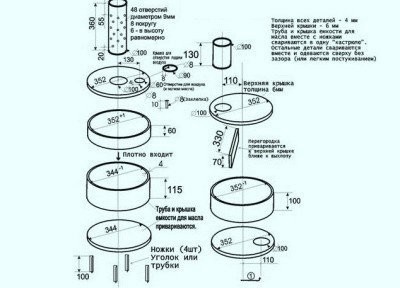
A detailed drawing of a homemade oil-fired furnace (mining), with accurate measurements of each individual structural part
Chimneymade of heat-resistant steel sheet, positioned above the upper tank. The upper part of the chimney can be made of galvanized steel, tin, ceramics, since there the gases have a lower temperature. The minimum possible height of the chimney is 4 meters, and the maximum value of this parameter can reach 7 meters.
The best heat dissipation is provided by a chimney flue made at an angle. However, the final section of such a pipe is still made vertical, which eliminates wind blowing. To protect the chimney from rain and snow, an umbrella or visor is constructed. When assembling a chimney, consider disassembling it to periodically clean the walls of settled soot and soot.
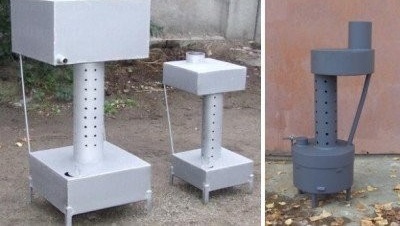
Legs in the amount of four pieces are made for a homemade stove working out from metal corners, ensuring its stable position
To the bottom of the tank are welded legs made of a metal corner or pipe sections. Then, a lid is put on this container, in which a hole is provided in advance for filling oil and air. The lid should fit snugly without forming the slightest gap with the container. A connecting pipe is welded to the cover, and an upper tank is attached to it. The chimney is connected to the second tank in the designated place.
The hole in the lid is equipped with an easily closing shutter, with the help of which the size of the gap affecting the burning power is controlled. This damper can also reduce soot emissions from the chimney.
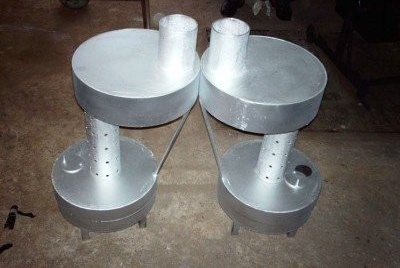
The hole located in the lower tank for filling the used oil is used to ignite the stove, as well as to regulate the traction
It’s not difficult to build such a homemade working stove. Small dimensions make it easy to transport, for example, from the garage to the cottage for heating the greenhouse. A simple design provides heating of the air at the outlet of the openings provided in the connecting pipe to a temperature of 90-95 degrees. With the help of such an oven, it is possible to raise the temperature in a heated room to a comfortable value very quickly.
Choosing a place to install
A home-made oven is installed so that around it there is free space on all sides. During operation, the walls of the heating structure become very hot, glowing red, so there should be no objects near the stove that contribute to a fire. Do not leave rags or other materials that may ignite near the stove. The design is installed on an even, solid base, which ensures its stability.
Features of furnace ignition
Here are some things to remember:
- Immediately before igniting the furnace, the chimney and lower tank are inspected for accidental ingress of water.
- After that, 2-3 liters of waste oil is poured through the hole in the lid.
- The oil is ignited using a lighted wick, twisted from rags and oiled, which is pushed into the container through the hole.
- It takes one to five minutes to flare up the oil. You can increase the speed of this process by adding a small amount of kerosene (half a glass) to mining.
- The traction hole is left ajar for 1-2 cm. If necessary, the gap is slightly reduced or, conversely, increased.
This video shows the ignition process of a homemade stove installed in the garage.
Safety Guidelines
It is forbidden to use gasoline, acetone and other flammable substances instead of used oil. When heating the garage, make sure that there are no canisters containing these substances near the ignited stove. In any of these cases, an explosion is inevitable.
It is also undesirable to get water into the container with oil, as this will result in a flame. It is easy to imagine the consequences, as everyone saw what happens when water droplets fall on a hot oil in a pan. When igniting a stove, water cannot be used to extinguish a fire, only a fire extinguisher, which should be in the room.
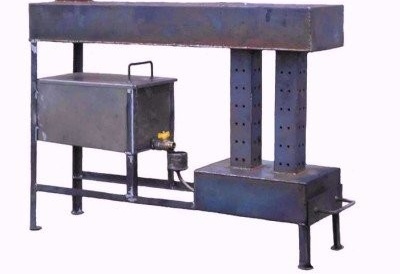
The model of the stove for heating large rooms works on waste oil coming from the tank into the tank through a tap
When the stove is running, the ventilation holes must be open. Do not cover them with anything or place them in any objects in order to prevent the increase in the concentration of carbon monoxide in the air above the maximum permissible values leading to poisoning.
Possible design improvements
Here's what you can do in addition to a regular stove:
- Using a fan, you can make a supercharged stove. The fan is installed in such a way that air flows blow over the entire structure of the home-made stove.At the same time, it is possible to increase the activity of the combustion process, as well as the rate of heat transfer in a heated room.
- The chimney can be combined with brickwork, thereby ensuring the best heating of the room. Heated brick cools longer than iron, so the heat in the room will remain longer.
- Another option for improving the design is to install a tank with water, which is connected by a pipeline to heating devices (radiators) that provide heating to the room.
- The top hot surface of the container can be used for boiling water and cooking.
Manufacturing of waste oil boilers
Boilers are more complex in design devices that can operate on waste oil. They can do it yourselfbut for safety reasons it is better to buy factory products. By the principle of operation, this heating equipment is similar to diesel-fired boilers.
When designing a heating boiler, the dimensions of the room to be heated using this equipment are taken into account. The height of the ceilings also matters. If it is planned to organize hot water supply in addition to heating, then double-circuit hot water boilers that also run on used, recycled oil. It is possible to use for these purposes and single-circuit boilers combined with a boiler.

Scheme of a boiler operating on waste, reusable engine oil or fuel oil. All parts are shown in centimeters.
As you can see, it is possible to organize heating on waste oil with your own hands both with the help of home-made devices and with the help of factory models. The use of the latter guarantees the safety of their operation, since all technological requirements are observed during assembly.

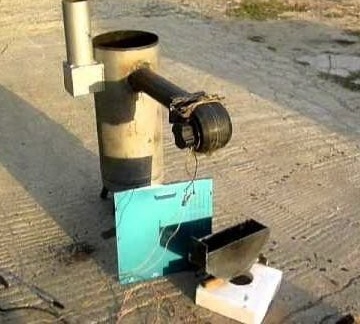
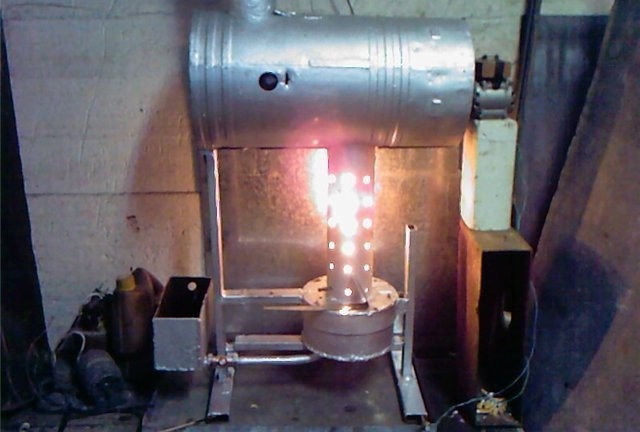
3 comments